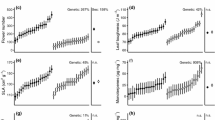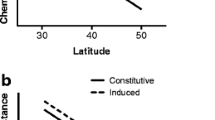Abstract
Sex is an ecologically important form of genetic variation in dioecious plants, with males and females generally differing in constitutive resistance to herbivores. Yet little is known about sexual dimorphism with respect to induced or indirect defense, or whether sex-based differences are underlain by trade-offs among modes of defense. We compared male and female Valeriana edulis plants for constitutive and induced direct resistance to two herbivores, an early-season caterpillar and a late-season aphid, and for constitutive and induced indirect resistance in terms of abundance of natural enemies and aphid-tending ants. No sexual dimorphism was found in constitutive direct plant resistance, yet the sexes differed for constitutive indirect resistance, with 78 % more natural enemies and 117 % more ants present on females than males. Past feeding damage by caterpillars induced direct and indirect resistance in both males and females, increasing caterpillar development time by 26 % and the abundance of natural enemies by 147 %. Caterpillar feeding did not induce direct resistance with respect to caterpillar final mass or aphid performance. In all cases, there were no interactions between the effects of caterpillar damage and plant sex. In summary, plant sexual dimorphism and induced responses to herbivore damage independently influenced herbivore performance and the composition of arthropod communities at higher trophic levels.


Similar content being viewed by others
References
Ågren J, Danell K, Elmqvist T (1999) Sexual dimorphism and biotic interactions. In: Geber MA, Dawson TE, Delph LF (eds) Gender and sexual dimorphism in flowering plants. Springer, Berlin; New York, pp 217–246
Ashman TL, King EA (2005) Are flower-visiting ants mutualists or antagonists? A study in a gynodioecious wild strawberry. Am J Bot 92(5):891–895
Ashman TL, Cole DH, Bradburn M (2004) Sex-differential resistance and tolerance to herbivory in a gynodioecious wild strawberry. Ecology 85(9):2550–2559
Ashman TL, Bradburn M, Cole DH, Blaney BH, Raguso RA (2005) The scent of a male: the role of floral volatiles in pollination of a gender dimorphic plant. Ecology 86(8):2099–2105
Banuelos MJ, Sierra M, Obeso JR (2004) Sex, secondary compounds and asymmetry. Effects on plant-herbivore interaction in a dioecious shrub. Acta Oecol-Int J Ecol 25(3):151–157. doi:10.1016/j.axtao.2004.01.001
Clancy KM, Price PW (1987) Rapid herbivore growth enhances enemy attack: sublethal plant defenses remain a paradox. Ecology 68(3):733–737
Cole DH, Ashman TL (2005) Sexes show differential tolerance to Spittlebug damage and consequences of damage for multi-species interactions. Am J Bot 92(10):1708–1713
Coley PD, Bryant JP, Chapin FS (1985) Resource availability and plant antiherbivore defense. Science 230(4728):895–899
Cornelissen T, Stiling P (2005) Sex-biased herbivory: a meta-analysis of the effects of gender on plant-herbivore interactions. Oikos 111(3):488–500
Delph LF (1999) Sexual dimorphism in life history. In: Geber MA, Dawson TE, Delph LF (eds) Gender and sexual dimorphism in flowering plants. Springer, New York, pp 149–173
Dicke M, Baldwin IT (2010) The evolutionary context for herbivore-induced plant volatiles: beyond the ‘cry for help’. Trends Plant Sci 15(3):167–175. doi:10.1016/J.Tplants.2009.12.002
Feeny PP (1976) Plant apparency and chemical defense. Recent Adv Phytochem 10(1):1–40
Feller IC, Kudoh H, Tanner CE, Wingham DF (2001) Sex-biased herbivory in Jack-in-the-pulpit (Arisaema triphyllum) by a specialist thrips (Heterothrips arisaemae). In: Marullo R, Mound L (eds) 7th International Symposium on Thysanoptera, Reggio Calabria, Italy. CSIRO Entomology, pp 163–172
Fine PVA, Mesones I, Coley PD (2004) Herbivores promote habitat specialization by trees in amazonian forests. Science 305(5684):663–665
Fritz RS, Crabb BA, Hochwender CG (2003) Preference and performance of a gall-inducing sawfly: plant vigor, sex, gall traits and phenology. Oikos 102(3):601–613
Galen C, Kaczorowski R, Todd SL, Geib J, Raguso RA (2011) Dosage-dependent impacts of a floral volatile compound on pollinators, larcenists, and the potential for floral evolution in the alpine skypilot Polemonium viscosum. Am Nat 177(2):258–272. doi:10.1086/657993
Geber MA, Dawson TE, Delph LF (1999) Gender and sexual dimorphism in flowering plants. Springer, Berlin, New York
Hare JD (2011) Ecological role of volatiles produced by plants in response to damage by herbivorous insects. Annu Rev Entomol 56:161–180. doi:10.1146/Annurev-Ento-120709-144753
Hatano E, Kunert G, Michaud JP, Weisser WW (2008) Chemical cues mediating aphid location by natural enemies. Eur J Entomol 105(5):797–806
Heimpel GE, Jervis MA (2005) Does floral nectar improve biological control by parasitoids? In: Wäckers FL, van Rijn PCJ, Bruin J (eds) Plant-provided food for carnivorous insects: a protective mutualism and its applications. Cambridge University Press, Cambridge, New York, pp 267–304
Houle G (1999) Nutrient availability and plant gender influences on the short-term compensatory response of Salix planifolia ssp. planifolia to simulated leaf herbivory. Can J For Res-Rev Can Rech For 29(12):1841–1846
Johnson MTJ, Stinchcombe JR (2007) An emerging synthesis between community ecology and evolutionary biology. Trends Ecol Evol 22(5):250–257. doi:10.1016/j.tree.2007.01.014
Karban R, Baldwin IT (1997) Induced responses to herbivory. University of Chicago Press, Chicago
Koricheva J, Nykanen H, Gianoli E (2004) Meta-analysis of trade-offs among plant antiherbivore defenses: are plants jacks-of-all-trades, masters of all? Am Nat 163(4):E64–E75
Koskela T, Puustinen S, Salonen V, Mutikainen P (2002) Resistance and tolerance in a host plant-holoparasitic plant interaction: genetic variation and costs. Evolution 56(5):899–908
Langenheim JH (1962) Vegetation and environmental patterns in the Crested Butte area, Gunnison County, Colorado. Ecol Monogr 32(2):249–285
Linhart YB (1991) Disease, parasitism and herbivory: multidimensional challenges in plant evolution. Trends Ecol Evol 6(12):392–396
Lloyd DG, Webb CJ (1977) Secondary sex characters in plants. Bot Rev 43(2):177–216
Ma GC, Hu HY, Niu LM, Fu YG, Peng ZQ, Bu WJ, Huang DW (2009) Adaptation of the externally feeding bug Elasmucha necopinata (Hemiptera: Acanthosomatidae) to its fig host. Symbiosis 49(3):133–136. doi:10.1007/S13199-009-0048-4
Marquis RJ (1992) Selective impact of herbivores. In: Fritz RS, Simms EL (eds) Plant resistance to herbivores and pathogens: ecology, evolution, and genetics. University of Chicago Press, Chicago, pp 301–325
Meyer F (1951) Valeriana in North America and the West Indies. Ann Mo Bot Gard 38(4):377–503
Mooney KA (2011) Genetically based population variation in aphid association with ants and predators. Arthropod-Plant Interact 5(1):1–7
Mooney KA, Agrawal AA (2008) Phenotypic Plasticity. In: Tilmon KJ (ed) Specialization, speciation, and radiation: The evolutionary biology of herbivorous insects. University of California Press, Berkeley, pp 43–57
Mooney KA, Halitschke R, Kessler A, Agrawal AA (2010) Evolutionary trade-offs in plants mediate the strength of trophic cascades. Science 327(5973):1642–1644. doi:10.1126/science.1184814
Mooney KA, Pratt RT, Singer MS (2012) The tri-trophic interactions hypothesis: Interactive effects of host plant quality, diet breadth and natural enemies on herbivores. PLoS ONE 7(4):e34403
Moran N, Hamilton WD (1980) Low nutritive quality as defense against herbivores. J Theor Biol 86(2):247–254
Nishida R, Fukami H (1989) Host plant iridoid-based chemical defense of an aphid, Acyrthosiphon nipponicus, against ladybird beetles. J Chem Ecol 15(6):1837–1845
Petry WK, Perry KI, Rudeen SK, Lopez M, Dryburgh J, Mooney KA Plant sexual dimorphism in the structure of a multi-trophic arthropod community (unpublished data)
Petry WK, Perry KI, Mooney KA (2012) Influence of macronutrient imbalance on native ant foraging and interspecific interactions in the field. Ecol Entomol 37(3):175–183. doi:10.1111/j.1365-2311.2012.01349.x
Polhemus DA (1988) Intersexual variation in densities of plant bugs (Hemiptera, Miridae) on Juniperus scopulorum. Ann Entomol Soc Am 81(5):742–747
Raguso RA (2009) Floral scent in a whole-plant context: moving beyond pollinator attraction. Funct Ecol 23(5):837–840. doi:10.1111/j.1365-2435.2009.01643.x
Rico-Gray V, Oliveira PS (2007) The ecology and evolution of ant-plant interactions. University of Chicago Press, Chicago
Rudgers JA (2004) Enemies of herbivores can shape plant traits: selection in a facultative ant-plant mutualism. Ecology 85(1):192–205
SAS Institute (2010) SAS version 9.2. SAS Institute, Cary, N.C
Soule JD (1981) Ecological consequences of dioecism in plants: a case study of sex differences, sex radios and population dynamics of Valeriana edulis Nutt. Ph.D., Michigan State University, East Lansing, p 157
Stadler B, Dixon AFG, Kindlmann P (2002) Relative fitness of aphids: effects of plant quality and ants. Ecol Lett 5(2):216–222
Styrsky JD, Eubanks MD (2007) Ecological consequences of interactions between ants and honeydew-producing insects. Proc R Soc B-Biol Sci 274(1607):151–164
Varga S, Kytoviita MM, Siikamaki P (2009) Sexual differences in response to simulated herbivory in the gynodioecious herb Geranium sylvaticum. Plant Ecol 202(2):325–336. doi:10.1007/s11258-008-9492-0
Wäckers FL, Rijn PCJv, Bruin J (2005) Plant-provided food for carnivorous insects: a protective mutualism and its applications. Cambridge University Press, Cambridge; New York
Wang YF, Jin LQ, Yu SH, Shi QW, Gu YC, Kiyota H (2010) Chemical constituents of plants from the genus Valeriana. Mini-Rev Org Chem 7(2):161–172
Wheeler AG (2009) Keltonia balli (Knight) (Hemiptera: Miridae: Phylinae): A rarely collected specialist on staminate flowers of the dioecious shrub Florida Rosemary (Ceratiola ericoides Michx.; Ericaceae). Proc Entomol Soc Wash 111(4):880–889
Whitham TG, Young WP, Martinsen GD, Gehring CA, Schweitzer JA, Shuster SM, Wimp GM, Fischer DG, Bailey JK, Lindroth RL, Woolbright S, Kuske CR (2003) Community and ecosystem genetics: a consequence of the extended phenotype. Ecology 84(3):559–573
Whitham TG, Bailey JK, Schweitzer JA, Shuster SM, Bangert RK, Leroy CJ, Lonsdorf EV, Allan GJ, DiFazio SP, Potts BM, Fischer DG, Gehring CA, Lindroth RL, Marks JC, Hart SC, Wimp GM, Wooley SC (2006) A framework for community and ecosystem genetics: from genes to ecosystems. Nat Rev Genet 7(7):510–523
Zangerl AR, Bazzaz FA (1992) Theory and pattern in plant defense allocation. In: Fritz RS, Simms EL (eds) Plant resistance to herbivores and pathogens: ecology, evolution, and genetics. University of Chicago Press, Chicago, pp ix, 590
Acknowledgments
This research was supported by National Science Foundation DEB-0919178 to KAM and DBI-0753774 to the Rocky Mountain Biological Laboratory and a RMBL Ehrlich Fellowship to KAM. Luis Abdala-Roberts, Anurag Agrawal, Jon Haloin and Jenifer Thaler provided useful comments on this manuscript, and Mitchell Lopez assisted with the fieldwork.
Author information
Authors and Affiliations
Corresponding author
Additional information
Handling Editor: Gary Felton
Rights and permissions
About this article
Cite this article
Mooney, K.A., Fremgen, A. & Petry, W.K. Plant sex and induced responses independently influence herbivore performance, natural enemies and aphid-tending ants. Arthropod-Plant Interactions 6, 553–560 (2012). https://doi.org/10.1007/s11829-012-9204-5
Received:
Accepted:
Published:
Issue Date:
DOI: https://doi.org/10.1007/s11829-012-9204-5




